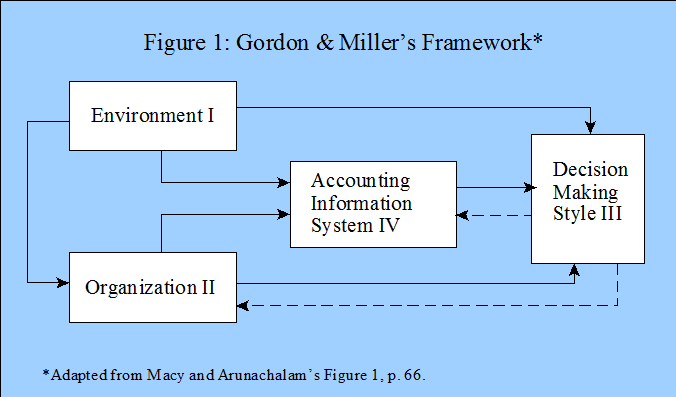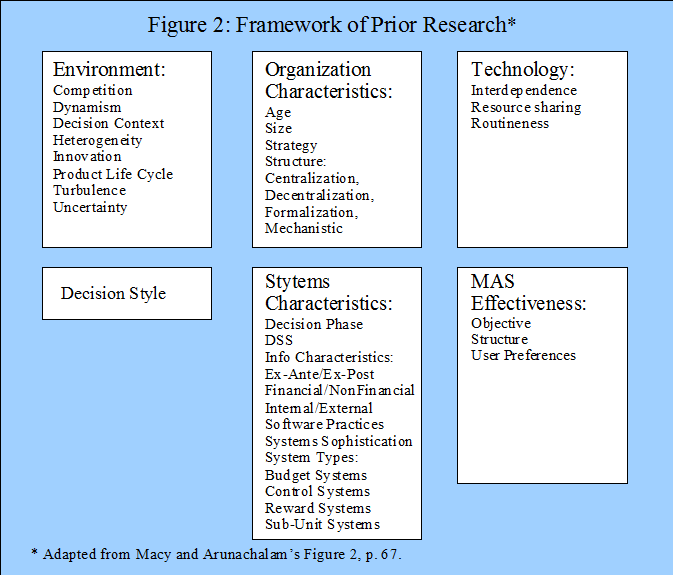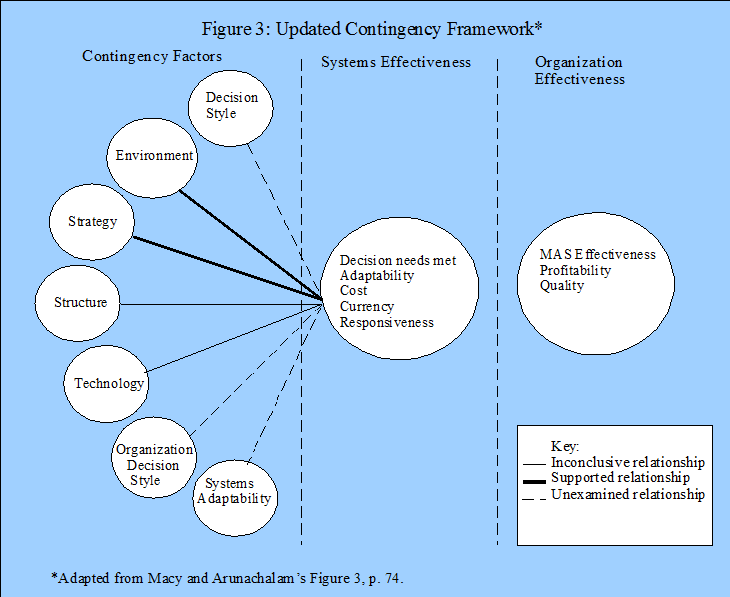
Summary by Anita Reed
Ph.D. Program in Accounting
University of South Florida, Spring 2002
Contingency Theory Main Page | Decision
Theory Main Page | Research Methods Main Page
The authors are motivated in the study by various methodological issues related to the existing research in management accounting systems (MAS) utilizing contingency theory. These issues include the use of individual data to represent organizations, non-insightful correlations between variables, inappropriate exclusion of variables and inappropriate or inconsistent measures of variables. The authors make two conclusions regarding the extant literature on contingency theory: 1) that it is "rather piecemeal in nature, requiring redirection and synthesis in order to enhance its value; and 2) the contingency framework may have been underspecified …" (p. 64), and they state their purpose in the current work as an effort to "integrate and interpret contingency theory research as it relates to MASs in order to draw descriptive as well as new prescriptive insights into the design of effective MASs" (p. 64) by reviewing the existing literature, developing a theoretical framework and utilizing the framework and methodological issues to suggest extensions to the research.
Review of Prior Research
The current study defines MAS as "those systems which support managerial planning, evaluation, and control activity and, in a broader sense, facilitate strategic choice" (p. 65). The use of contingency theory would suggest that organizations align their systems and processes with their environment (external factors) and strategy (internal factors), and that the effectiveness of MAS will depend on the extent to which the MAS’s characteristics meet the requirements of the various contingencies faced by the organization.
The MAS characteristics studied in prior research are based on the accounting information systems framework proposed by Gordon & Miller (see Figure 1) and include the following: environment, technology, organizational characteristics, decision style, systems characteristics and MAS effectiveness.

Figure 2 provides an outline of the contingency variables used in prior research and the most common operationalizations of each characteristic.

Environment is defined for this study as "phenomena that are external to the organization and which have either potential or actual influence on the organization" (p. 68). Uncertainty is the most commonly used measure of environment in prior research. Technology is defined as "the organizational process of transforming inputs into outputs" (p. 68). Technology has been measured by a number of factors, with the two most consistent being routineness and interdependence. Organizational characteristics have most consistently been measured by structure ("the patterns and relationships that exist among organization or work unit elements" p. 69) and strategy ("the determination of the basic long-term goals and objectives of an enterprise, and the adoption of courses of action and the allocation of resources necessary for carrying out these goals" p. 69). Decision style is "the decision style used by executives to help the organization better cope with the environment" (p. 69), and is an individual characteristic used to represent the organization. The existing literature does not contain a measure of organizational decision style. Systems characteristics are typically measured using "the type of data reported by the system" (p. 70) and three data type characteristics have shown some consistency in the existing literature: internal/external, financial/nonfinancial and ex post/ex ante. Measuring MAS effectiveness has been problematic in the prior research. Two approaches have been to measure either user preferences or actual usage.
Based on their review of the existing literature, the authors contend that key contingent variables have either been ignored or measured inappropriately, contributing to lack of generalizability of the results and an inability to draw unequivocal conclusions. Their assessment is that the factors associated with the effective design of MAS have not been properly specified and that an explicit framework for evaluating MAS using a contingency theory approach has not been developed. They then propose such a framework and refine the factors that should be examined. They also make recommendations regarding various methodological issues.
An Updated Contingency Framework
The authors use the Gordon and Miller framework as a starting point for developing a more explicit framework and also adapt Franz and Robey’s distinction between factor and process research. They define factor research as follows: factor research "empirically examines user and situational attributes to see how they relate to the outcome of system implementation", process research "emphasizes managing the organizational change that takes place during the development of the system" (Franz & Robey, 1987, p. 207). The use of both factors and processes as variables of interest are needed to expand the value of research in the design of MAS.
To expand the framework, the authors include systems change (adaptability) and organizational decision making as processes instead of factors. Figure 3 illustrates the updated contingency framework and highlights the various relationships that have been studied in prior research. The relationships between decision style, systems adaptability and organizational decision style have yet to be examined and represent opportunities for future research.

Decision style is a factor that has not been properly defined or measured in previous research, as discussed in the previous section. It represents the "range of individual variations in decision style that can be found among the decision makers within the organization" (p. 76). Systems change (adaptability) is the ability of MAS to adapt to changes in the organization’s internal and external environment. It is viewed as a process in the framework. These changes include structural changes, information processing changes, external changes and procedural changes. These changes impact the organizations technology, people, policies and procedures and both renovation of existing MAS and new implementations should be examined with a view towards increasing adaptability to future changes. Organizational decision style is also viewed as a process in the framework and is "concerned with how organizations make decisions, what information is needed to make decisions and how those needs can be supported" (p. 76). Use of a decision orientation allows the researcher to develop measures of systems effectiveness that are both practical and meaningful. The value of this perspective has been discussed in the information systems literature, but has not been examined in the contingency literature with respect to MAS design. Factors related to the organizational decision making process include technological complexity, overall organizational strategy, and organizational structure.
Two methodological issues are identified as essential to the evaluation of MAS design utilizing the contingency theory: "theoretically-based measures of effectiveness and an adaptive mechanism through which effectiveness is achieved" (p. 77). These require future research to address issues regarding the method and level of analysis used. Contingency theory implies a conditional association of two or more independent variables with a dependent outcome. This relationship cannot be evaluated using correlation or unmoderated regression, methods commonly utilized in prior research, but instead requires the use of analysis methods that examine fit using either a reductionist or holistic approach. Path analysis is one such method. One other issue to be addressed is the level of measurement. Previous studies have measured data at the individual level and used it in aggregated form to represent organizational level data. This may lead to inconsistent results or to inappropriate conclusions if the individual level data is not representational of the entire organization. Data should be collected and measured at the appropriate level for the research question being addressed.
The authors also encourage development of more representational measures of effectiveness. Effectiveness is a multidimensional construct, with important dimensions being efficiency and goal attainment. One recommendation for developing measures of effectiveness is to utilize the decision-making context and to adopt the criterion suggested by Huber and McDaniel of measuring effectiveness as "the maximization of the quality (broadly defined and including timeliness) of organizational decisions" (Huber & McDaniel, 1986, p. 573).
In conclusion, the authors are "positive about the potential for contingency research in the future", which should "specify meaningful system and organizational characteristics that impact actual usage patterns and the capability of these systems to improve the quality, effort or timeliness of decision making" (p. 81). They encourage further refinement of the framework and variables, taking into consideration the constraint of increased data requirements.
__________________________________________
Related summaries:
Chenhall, R. H. 2003. Management control system design within its organizational context: Findings from contingency-based research and directions for the future. Accounting, Organizations and Society 28(2-3): 127-168. (Summary).
Chenhall, R. H. and K. Langfield-Smith. 1998. The relationship between strategic priorities, management techniques and management accounting: An empirical investigation using a systems approach. Accounting, Organizations and Society 23(3): 243-264. (Summary).
Fullerton, R. R. and C. S. McWatters. 2002. The role of performance measures and incentive systems in relation to the degree of JIT implementation. Accounting, Organizations and Society 27(8): 711-735. (Summary).
Ittner, C. D. and D. F. Larcker. 1997. Quality strategy, strategic control systems, and organizational performance. Accounting, Organizations and Society 22(3-4): 293-314. (Note).
Kaplan, S. E. and J. T. Mackey. 1992. An examination of the association between organizational design factors and the use of accounting information for managerial performance evaluation. Journal of Management Accounting Research (4): 116-130. (Summary).
Libby, T. and J. H. Waterhouse. 1996. Predicting change in management accounting systems. Journal of Management Accounting Research (8): 137-150. (Summary).
Martin, J. R. Not dated. What is contingency theory? Management And Accounting Web. Contingency Theory
Moores, K. and S. Yuen. 2001. Management accounting systems and organizational configuration: A life-cycle perspective. Accounting, Organizations and Society 26(4-5): 351-389. (Summary).
Neimark, M. and T. Tinker. 1986. The social construction of management control systems. Accounting, Organizations and Society 11(4-5): 369-395. (Summary).
Sim, K. L. and L. N. Killough. 1998. The performance effects of complementarities between manufacturing practices and management accounting systems. Journal of Management Accounting Research (10): 325-346. (Summary).
Tiessen, P. and J. H. Waterhouse. 1983. Towards a descriptive theory of management accounting. Accounting, Organizations and Society 8(2-3): 251-267. (Summary).